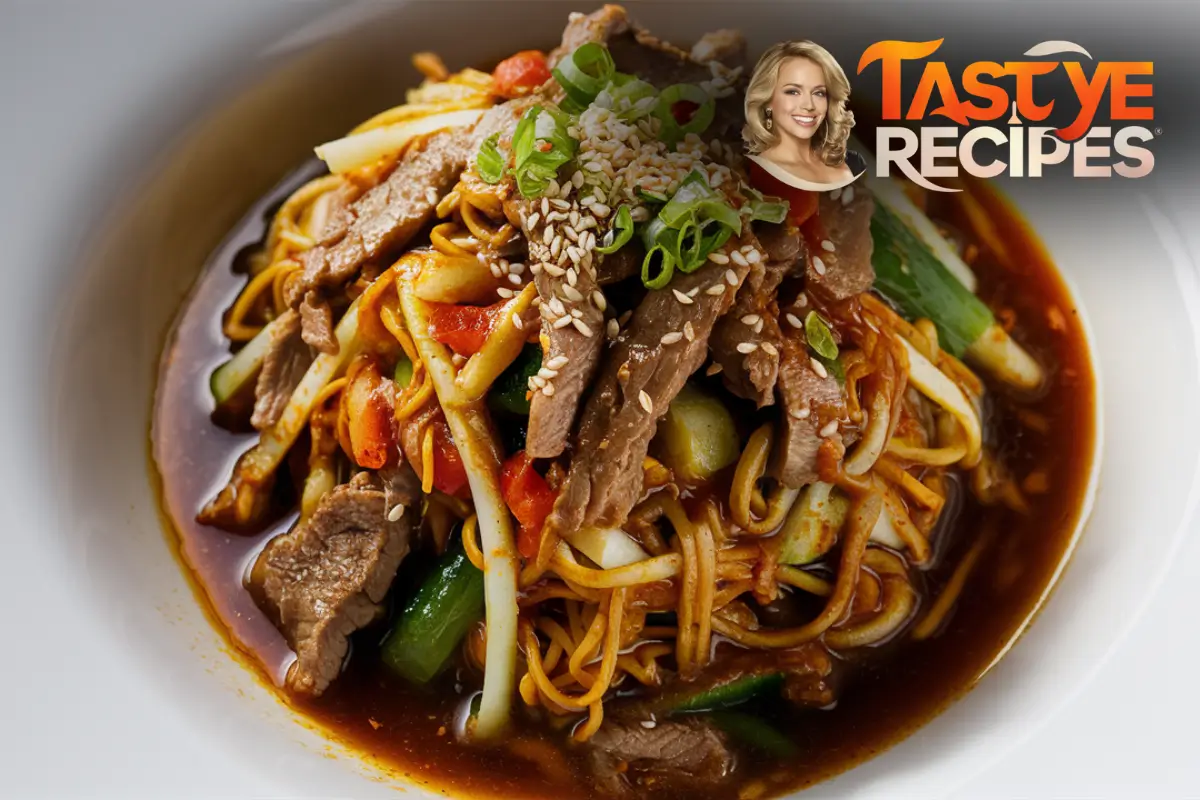Beef Chow Mein
Beef Chow Mein is a popular dish in Asian cuisine, celebrated for its savory flavors and satisfying textures. This dish features tender strips of beef, stir-fried with vegetables and noodles, all coated in a flavorful sauce. It’s perfect for a quick weeknight dinner or a special meal. Beef Chow Mein is both versatile and easy to prepare. Whether you’re a seasoned cook or just starting, this recipe offers a delightful combination of flavors that you can customize to your taste. It’s ideal for those looking to explore Asian cooking or enjoy a comforting meal at home.
Ingredients for Beef Chow Mein
To create the perfect Beef Chow Mein, selecting fresh and high-quality ingredients is key. You’ll need tender cuts of beef such as flank steak or sirloin, which should be sliced thinly against the grain to ensure tenderness and quick cooking. Noodles, specifically chow mein or thin egg noodles, provide the right texture and absorb the sauce beautifully. A variety of vegetables, including bell peppers, carrots, cabbage, and bean sprouts, add color, crunch, and nutritional value. The sauce, made from soy sauce, oyster sauce, hoisin sauce, and a touch of sesame oil, forms a flavorful base. Garlic, ginger, and green onions enhance the depth of flavor. Optional additions like mushrooms, bok choy, or snap peas can be included for extra flavor and variety.
Step-by-Step Instructions
Preparation: Start by gathering all necessary ingredients. Slice the beef thinly and marinate it in a mixture of soy sauce and cornstarch to tenderize and flavor the meat. Meanwhile, chop the vegetables into bite-sized pieces to ensure even cooking. Cook the noodles according to the package instructions, then drain them and set them aside. This preparation stage is crucial for an efficient cooking process and ensures that everything is ready to go once you start stir-frying.
Cooking the Beef Chow Mein
Heat a tablespoon of oil in a wok or large skillet over high heat. Stir-fry the beef in batches to avoid overcrowding the pan, which helps achieve a nice sear. Cook until the beef is browned and thoroughly cooked, then remove it from the wok and set it aside. This step ensures that the beef remains tender and flavorful. Using high heat helps to lock in the juices and gives the beef a great texture, which is essential for the dish.
Stir-Frying Vegetables
In the same wok, add more oil if necessary. Stir-fry the garlic and ginger until fragrant, which should take about 30 seconds. These aromatics add a foundational flavor to the dish. After that, add the vegetables and continue to stir-fry for a few minutes. It’s important to cook them until they start to soften but still maintain a crisp texture, which adds a vibrant, crunchy component to the dish. This method of quick cooking over high heat helps to preserve the vegetables’ color and nutrients.
Combining Ingredients
Return the beef to the wok along with the cooked noodles. Pour the sauce mixture over all the ingredients, ensuring everything is well coated. Toss everything together until thoroughly heated through. At this stage, you can adjust the seasoning with additional soy sauce or a splash of water if needed, which helps achieve a harmonious blend of flavors. This final mixing step integrates the flavors and ensures that each bite is delicious and balanced.
Serving Beef Chow Mein
Serve the Beef Chow Mein hot, garnished with chopped green onions and sesame seeds if desired. This garnish enhances the flavor and adds a visually appealing element to the dish. For the best experience, serve immediately to enjoy the fresh flavors and textures. This dish can be enjoyed on its own or paired with other Asian-inspired dishes. It’s versatile enough to be a main course or part of a larger meal spread, making it a popular choice for both casual dinners and special occasions.
Tips for Making the Best Beef Chow Mein
For the best Beef Chow Mein, consider these helpful tips. Slice the beef thinly and against the grain to ensure tenderness, and marinate it with soy sauce and cornstarch for added flavor. This step helps tenderize the meat and infuses it with flavor. When stir-frying, cook the ingredients quickly over high heat to keep the vegetables crisp and the beef tender. Fresh noodles are ideal for this dish, but if using dried noodles, cook them just until al dente to avoid a mushy texture. Balancing flavors is key; taste the dish before serving and adjust the seasoning if necessary, using a splash of water or broth if the dish is too salty. These tips help in achieving a perfect balance of flavors and textures.
Serving Suggestions
Beef Chow Mein is a versatile dish that pairs well with various accompaniments, enhancing the overall dining experience. Serve it with steamed jasmine or basmati rice, which adds an extra layer of heartiness to the meal. Pairing it with appetizers like spring rolls or dumplings can add variety and complement the flavors of the chow mein. For added texture, serve with crispy fried noodles either on top or on the side. Offering a selection of condiments such as soy sauce, chili sauce, or sweet and sour sauce allows diners to customize their meal to their taste preferences. This versatility makes Beef Chow Mein a popular choice for different occasions and dining styles.
Nutritional Information and Benefits
Beef Chow Mein provides a balanced mix of nutrients, making it a wholesome and satisfying meal option. The beef is a good source of protein, essential for muscle repair and growth. Noodles contribute carbohydrates, which are a primary energy source necessary for daily activities. The vegetables in the dish add a range of vitamins and minerals, including fiber, which promotes digestive health and overall well-being. The use of sesame oil adds healthy fats, important for brain function and cell growth. This combination of nutrients makes Beef Chow Mein not only delicious but also beneficial for maintaining a balanced diet.
Caloric and Macronutrient Breakdown
A typical serving of Beef Chow Mein provides approximately 400-500 calories, depending on the portion size and specific ingredients used. Protein content ranges from 20-25 grams, primarily from the beef, making it a good source of this essential nutrient. The dish contains about 10-15 grams of fat, including healthy fats from sesame oil, which contribute to heart health. Carbohydrates, which provide energy, make up about 50-60 grams per serving, sourced from the noodles and vegetables. Additionally, the dish offers approximately 5-7 grams of fiber, which supports digestive health and adds to the meal’s overall nutritional value.
Proper Storage and Reheating of Beef Chow Mein
Beef Chow Mein is convenient for leftovers and can be stored and reheated with ease. Store leftovers in an airtight container and refrigerate them for up to three days to maintain freshness. When ready to eat, reheat in a wok or skillet over medium heat, adding a splash of water to prevent the noodles from drying out. Stir frequently to ensure even heating. Avoid using a microwave, as it can make the noodles and vegetables soggy. These storage and reheating tips help maintain the dish’s quality and flavor, making it a great option for meal prep or enjoying the next day.
Safety Tips
When preparing Beef Chow Mein, it’s essential to follow food safety guidelines to ensure a healthy meal. Proper handling of beef includes using fresh cuts and storing them correctly to prevent spoilage. Beef should be cooked to a safe internal temperature of at least 145°F (63°C) to ensure it is safe to eat. Washing vegetables thoroughly removes pesticides and contaminants, which is crucial for food safety. Additionally, avoiding cross-contamination by using separate cutting boards and utensils for raw meat and vegetables is important to prevent the spread of bacteria. Following these safety measures ensures that your meal is not only delicious but also safe to eat.
Frequently Asked Questions
- Can I use a different type of meat in this dish? – Yes, chicken, pork, or tofu are great alternatives. Adjust the cooking time accordingly to ensure the meat is fully cooked and tender.
- What if I don’t have chow mein noodles? – You can use other types of noodles like spaghetti or rice noodles, though the texture may differ slightly, giving the dish a unique twist.
- Is it necessary to use a wok? – While a wok is ideal for stir-frying due to its shape and heat distribution, a large skillet can also work well if a wok is unavailable.
- Can I make this dish gluten-free? – Yes, use gluten-free soy sauce and noodles. Ensure all other ingredients are gluten-free to accommodate dietary restrictions.
- How can I add more vegetables to the dish? – You can add extra vegetables like bok choy, broccoli, or snap peas, which will enhance the nutritional content and add variety.
- What sauce can I use if I don’t have oyster sauce? – Hoisin sauce or a mix of soy sauce and a touch of sugar can substitute oyster sauce, providing a similar flavor profile.
Conclusion
Beef Chow Mein is a classic and flavorful dish that brings the delicious taste of Asian cuisine to your home. Whether served as a main dish or alongside other Asian-inspired favorites, Beef Chow Mein is sure to be a hit. Enjoy this hearty and satisfying meal, perfect for any occasion, and delight in the blend of tender beef, crunchy vegetables, and savory noodles. This dish not only satisfies your taste buds but also provides a balanced and nutritious meal option
Beef Chow Mein Recipe
Ingredients
- 8 ounces chow mein noodles or thin egg noodles
- 1 pound beef sirloin or flank steak, thinly sliced
- 2 tablespoons vegetable oil
- 1 onion, thinly sliced
- 2 cloves garlic, minced
- 1 cup cabbage, shredded
- 1 cup bell peppers, thinly sliced
- 1 cup bean sprouts
- 2 green onions, chopped
- 3 tablespoons soy sauce
- 2 tablespoons oyster sauce
- 1 tablespoon hoisin sauce
- 1 teaspoon sesame oil
- 1/2 teaspoon sugar
- Salt and pepper, to taste
- Sesame seeds (optional, for garnish)
Instructions
Prepare the Noodles:
First, cook the chow mein noodles according to the package instructions. Once they are cooked, drain and rinse them under cold water to stop the cooking process. Then, set the noodles aside, tossing them with a small amount of oil to prevent sticking. This step ensures the noodles won’t clump together later.
Marinate the Beef:
Meanwhile, in a bowl, combine the beef slices with 1 tablespoon of soy sauce and a pinch of sugar. Let the beef marinate for at least 10 minutes. This marination not only helps tenderize the beef but also infuses it with flavor, enhancing the overall taste of the dish.
Cook the Beef:
Next, heat 1 tablespoon of vegetable oil in a large skillet or wok over medium-high heat. Once the oil is hot, add the marinated beef slices. Stir-fry the beef until it is browned and cooked through, which should take about 3-4 minutes. After cooking, remove the beef from the skillet and set it aside.
Stir-Fry the Vegetables:
In the same skillet, add another tablespoon of oil. Add the sliced onion and minced garlic, and stir-fry for about 1 minute until they become fragrant. Then, add the shredded cabbage and bell peppers. Stir-fry the vegetables for another 2-3 minutes, or until they start to soften. Afterward, add the bean sprouts and green onions, and stir-fry for an additional 1-2 minutes, ensuring all vegetables are well-mixed and cooked evenly.
Combine Ingredients:
Now, return the cooked beef to the skillet. Add the cooked noodles, soy sauce, oyster sauce, hoisin sauce, and sesame oil. Stir everything together thoroughly until the noodles and beef are well coated with the sauce and the mixture is heated through. This step brings all the flavors together, creating a harmonious and delicious dish.
Season and Serve:
Finally, taste the dish and adjust the seasoning with salt and pepper as needed. If desired, garnish with sesame seeds for added texture and flavor. Serve the chow mein hot, enjoying the blend of savory beef, fresh vegetables, and perfectly seasoned noodles


